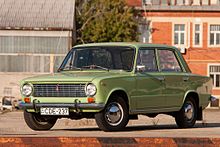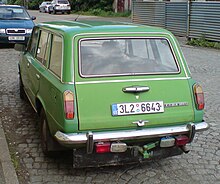Schiguli (automobile)
Schiguli ( Russian Жигули [ ʐigʊli ], transcription in the GDR Shiguli ) is a series of vehicles from the automobile manufacturer AwtoWAS . The Shiguli was designed as a middle-class car that should cost three and a half times the annual income of an average Soviet worker. Technically, the Schigulis are license replicas of the Fiat 124 , a sedan with a front engine and rear-wheel drive. Between 1970 and 2014, seven types of the Schiguli were built, with the combination versions being given their own type designation. About 17.3 million units were created. In export markets, the Schiguli was mostly offered as a Lada . In 1975 Shiguli production accounted for around 50% of automobile production in the USSR. In addition to AwtoWAS, contract manufacturers also built the Schiguli , including Ischmasch and LuAS .
history
The AwtoWAS plant in Tolyatti was built at the end of the 1960s with the help of Fiat, and the first six Shiguli 2101s rolled off the production line on April 19, 1970. In 1971 the station wagon version 2102 followed , in 1972 the "luxury" version 2103 based on the Fiat 124 S with upgraded equipment and a more powerful engine. From 1971 the vehicles were also exported. The production of these "classic" Schigulis or "Pfennig" Schigulis ended in 1988. The successor to the 2103 followed in 1975, now referred to as 2106 , with an enlarged engine and less chrome trim. Production of the 2106 stopped in 2006. The successor to the classic Schiguli was the 2105 , which was produced from 1979, and which was also available in the upscale version as the 2107 from 1982 . The Kombi 2102 was replaced by the Kombi 2104 in 1984 . Production of the 2105 was stopped in 2010, and from 2011 production of the 2107 was relocated to Ischmasch. The last Schiguli at AwtoWAS, a 2104, rolled off the assembly line on September 17, 2012. The 2107 was still being built in Egypt until August 2014, when the production plant burned down there.
Type overview
A total of seven different types of Schigulis were created , which were built in various modifications.
Schiguli types
- WAS-2101 - First model, sedan
- WAS-2102 - Combination version of the WAS-2101
- WAS-2103 - High quality equipment, double headlights
- WAS-2104 - station wagon based on the sedan 2105
- WAS-2105 - Facelift of the WAS-2101 with rectangular headlights
- WAS-2106 - WAS-2103 with more powerful engines and less chrome trim
- WAS-2107 - Superior equipment, based on the 2105
Source: Kanunnikow
Timeline

Numbers of items according to various sources

- Total approx. 17,300,000,
-
- including around 6,700,000 copies of the WAS-2101 + 2102 + 2103 by 1988
- including more than 1,500,000 copies of the WAS-2101 by 1974
- including at least 660,000 copies of the WAS-2102 by 1985
- of which exactly 1,304,866 copies of the WAS-2103 up to 1984
- including around 1,100,000 copies of the WAS-2104 by 2012
- of which by 2011 approx. 2,087,000 copies of the WAS-2105
- (until 2002 exactly 1,858,954 copies)
- including around 4,300,000 copies of the WAS-2106 by 2005
- including around 3,100,000 copies of the WAS-2107 by 2014
technology
The Schiguli is a compact class vehicle and was built as a four-door sedan, two-door pick-up truck or station wagon. The body is self-supporting, the engine is installed lengthways at the front and drives the rear wheels via a four-speed gearbox and a cardan shaft . The front wheels are individually on each of two unequal length wishbones hung, the rear axle is a coil springs live axle , at four trailing arms and a Panhard rod . Technically, the Schiguli is based on the Fiat 124, but differs from it in over 800 points in order to adapt the car to the conditions of the poor Soviet roads. For this purpose, the thickness of the sheet metal was increased, the body was raised by 30 mm to 170 mm, and the suspension was adjusted to be softer. The disc brakes on the rear axle were replaced by drum brakes . Instead of the Fiat engine with a side camshaft , a gasoline engine developed by NAMI with an overhead camshaft and rocker arms was installed. It is available in different cubic capacities, originally it had 1198 cm³ and an output of 62 HP (46 kW) (according to GOST 8.417). Later came variants of 1.2 liters with 64 PS (46.9 kW), 1.3 liters with 63 PS (46.8 kW), 1.5 liters with 70 PS (51.6 kW) and 1.6 liters with 74 PS (54.8 kW) (according to GOST 14846–81).
swell
Literature sources
- В. А. Вершигора, А. П. Игнатов, К. В. Новокшонов, К. Б. Пятков: Автомобили 'Жигули моделей ВАЗ-2104, -2105, -2107: Устройство и ремонт 2nd edition, Transport-Verlag, 1996, ISBN 5-277-01947-2 .
- Сергей В. Канунников: Отечественные легковые автомобили. 1896-2000 гг. ООО «Издательство" За рулем "", 2013, ISBN 978-5-9698027-5-9 , p. 59-68; 71-76; (80,87,90,214,240–245,330,337,363,481,491,492) ( limited preview in Google Book search).
- Lewis H. Siegelbaum: Borders of Socialism: Private Spheres of Soviet Russia , Springer, 2006, ISBN 978-1-4039-8454-8
- Andy Thompson: Cars of the Soviet Union , Haynes Publishing, Somerset, 2008
Online sources
- ↑ AwtoWAS: Annual Report 2003 , pp. 48 + 49
- ↑ a b c d e f Tass: 45 лет с момента старта: знаменитые автомобили АвтоВАЗа , March 24, 2016, accessed July 2, 2018
- ↑ a b Awtostat: The cheapest Russian car was removed from production , February 14, 2011, accessed July 2, 2018
- ↑ 17 сентября будут сделаны последние "Жигули" , in auto.mail.ru, September 11, 2012, accessed on July 2, 2018
- ↑ Tass: В Египте горит завод по производству автомобилей "Лада" , August 4, 2014, accessed on July 2, 2018









